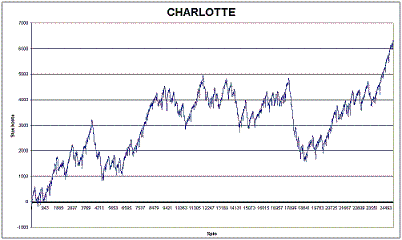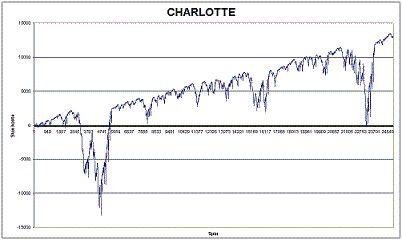This roulette system is called the Charlotte basically is very simple. You start betting on a certain number until you hit. You play the game by using the following progression:
- 2 units within the first 27 spins
- 3 units within the next 10 spins
- 4 units within the next 8 spins
- 5 units within the next 6 spins
- 6 units within the next 6 spins
- 7 units within the next 4 spins
- 8 units within the next 4 spins
- 9 units within the next 4 spins
- 10 units within the next 4 spins
- 11 units within the next 3 spins
- 12 units within the next 3 spins
- 13 units within the next 3 spins
- 14 units within the next 2 spins
- 15 units within the next 2 spins
- 16 units within the next 2 spins
- 17 units within the next 1 spin.
If the roulette hits a certain number within 88 spins (occurs roughly 50% of the time), you make a profit depending on in which spin you hit this number. If you do not hit a certain number within 88 spins, you have a loss of 523 units.
What do the Statistics say?
Let’s ask a simple question. What are the odds of not hitting a certain number within 88 spins? Generally, the probability is 3 688/3 788 (so it is 8, 97%). The odds are not so small. Average winnings can reach a profit of about 50 units, but we can make a loss of about 140 units per 100 spins (91, 03 * 50 – 8, 97 * 523). Therefore this system appears to go below zero in long-term betting.
On the following graph you can see a progression per 25.000 spins:


As shown on the first graph the system oscillated enough, but unfortunately, it went below zero and resulted in a loss (albeit, only mildly). Sometimes we observed an upward trend of the curve (just as on the second graph). It meant that winnings in each series depending on in which spin you hit a certain number because a certain profit oscillated from 20 to 80 units (but these 60 units are inaccurate averages). Therefore there is an opportunity to expect the profit of higher values, unfortunately, we cannot rely on it.
We attempted to apply some modifications such as altering the length of the game (shortening or lengthening), but the graphs did not change in the long ratio and appeared roughly the same. In the case of lengthened series, the upward trend achieved dominance and it was accompanied by the fluctuation of the curve in the long-term testing (as Martingale progression). In the case of shortened series, the dispersion was decreased but the curve also went below zero.
But this is only an empirical finding by testing over 100.000 spins. The exact statistical calculation would be expressed as quite difficult because of a different profit on each spin.
We also attempted to test this system by applying the basic progression of the series. So after each losing series, we increased the size of the bet by 1 unit until we made a profit. What was the outcome?

We could observe the upward trend, sometimes accompanied by some local slumps which resulted in a loss in short term. Therefore this variant is still too dangerous, however, the system looks good and it can work well as a part of some complex systems using a bigger amount of gambling strategies altogether.
Moreover, we have prepared a roulette betting simulator, where you can try this system for free.

 EN
EN  čeština
čeština  Polski
Polski  Slovenčina
Slovenčina  Русский
Русский  Deutsch
Deutsch  Slovenski
Slovenski  Dutch
Dutch  Svenska
Svenska  Português
Português  Italiano
Italiano  Español
Español  Français
Français  Suomalainen
Suomalainen  Български
Български  Românesc
Românesc  Magyar
Magyar  Eesti
Eesti  Ελληνική
Ελληνική  Latviešu
Latviešu  Lietuvių
Lietuvių  やまと
やまと  中国
中国  Dansk
Dansk  Türkçe
Türkçe  ID
ID  Українська
Українська  한국어
한국어  Norsk
Norsk  Peter Sommer
Peter Sommer 





You have to be logged in to add a comment